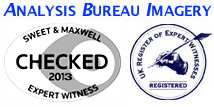A range of traditional analogue techniques, such as is obtained from the employment of equipment that generates freeze frames and slow motion from the imagery exhibit, creates more easily definable results which may then be analysed in greater detail. A range of new technological techniques, including digitisation, enlargement, enhancement and titling provides the facility to optimise an image and /or range of images and is able to produce a clarity of imagery exhibit which is often not able to be viewed via alternative methods. Whilst working in the digitised video format, we frequently generate video at up to approximately thirty frames per second, which, when coupled with techniques such as interpolation, often reveal detail that could otherwise be overlooked and /or misconstrued. These techniques therefore apply strongly to security CCTV video, RTA CCTV video, digital, world wide web and internet imagery. A range of illustrative hard copy prints, in full colour where applicable, is frequently generated and form an evidential section of the Report. Our techniques normally allow for multiple copies of the relevant hard copy prints to be made available including for the ease of distribution to Jury members and Court officials, if required.
SPECIALIST AREA OF OPERATION:
Facial Mapping and face comparison. Imagery Analysis including analysis of security CCTV video, RTA CCTV video, still imagery and audio. ABH, GBH and Section 18. Chronology, Comparative Analysis and Photogrammetry. Crime scene video surveillance. Expert witness Report preparation and presentation. Court attendance is normally available by prior arrangement.
Our expertise includes:-
1] Chronology: "the provision of a Report covering the evolution of an incident along a predetermined time line"
2] Comparative Analysis: "the provision of a Report covering the comparison of a specific object or person which/who appears in one set of images with a specific object or person which/who appears in another set of images and considering the likelihood or otherwise of the object or person being the same"
3] Photogrammetry: "the determining of dimensional data from imagery as accurately as possible which is then able to be compared with actual physical dimensions obtained from on site measurement"
Facial mapping Huge amounts of video data (including CCTV) are captured every day. The Analysis Bureau Imagery employs advanced video facilities that can assist to dramatically improve the quality of recorded video imagery, from which salient still images may be produced for further, more detailed analysis. We are able to advise with respect to the quality of CCTV evidence, particularly in the ability to provide identification evidence. We are able to assess the suitability of still and video images for facial mapping, clothing and body comparison. Video forensics More and more immense amounts of video data is being captured around the world each day. This video data is growing exponentially in importance as evidence. Video forensics services such as those provided by The Analysis Bureau Imagery are core to the expert analysis and interpretation of this imagery. Video forensics services include: * Still image and video enhancement * Enhanced quality still prints from video * Video editing [where permissible] * Enhancement of time-lapse CCTV footage * Assessment of faulty or tampered with still images or video recordings * De-multiplexing of CCTV * Highlighting of subjects or objects * Expert opinion on video content * Consultation with respect to any evidential benefit of imagery evidence * Application of subtitles * Vehicle speed estimations * Consideration of tampered with or edited video tapes * Digital format conversion CCTV Imagery The ability to catch criminals from CCTV footage on the way - By Daily Mail Reporter Merseyside police Chief Constable Bernard Hogan-Howe Merseyside police Chief Constable Bernard Hogan-Howe: His force is piloting 'facial mapping' schemes Police are within months of setting up the country's first system that recognises suspected criminals and terrorists from CCTV footage. The 'facial mapping' scheme will enable officers to identify wanted criminals within minutes of being caught on tape. It will compare photos from a digital mugshot database with film and stills from a crime scene and come up with around ten of the closest matches. To build up its mugshot database, Merseyside Police – which is running the pilot scheme along with Lancashire Police and West Yorkshire Police – is taking digital photographs of 70,000 suspects arrested in Liverpool every year. These include those accused of minor crimes such as motoring offences and the images will be retained even if they are not charged with any offence. The chief constable of Merseyside Police, Bernard Hogan-Howe, told the magazine New Statesman: 'In future we could scan images of shoplifters and motorists who drive off from petrol stations without paying. 'Another example would be someone who is photographed committing an assault outside a nightclub.' He said the system could be up and running 'later this year'. © By Daily Mail Reporter For further details, please see: METHODOLOGY and / or CONTACT US ************* Facial mapping, body comparison, image analysis, CCTV interpretation, video enhancement, expert comment - the role of an Expert Witness For further details, please see: METHODOLOGY and / or CONTACT US
